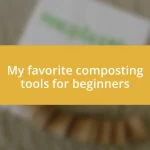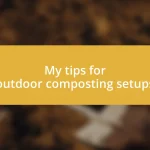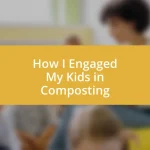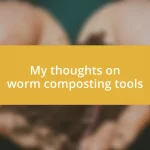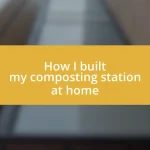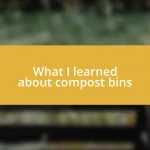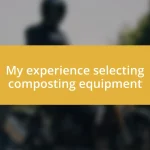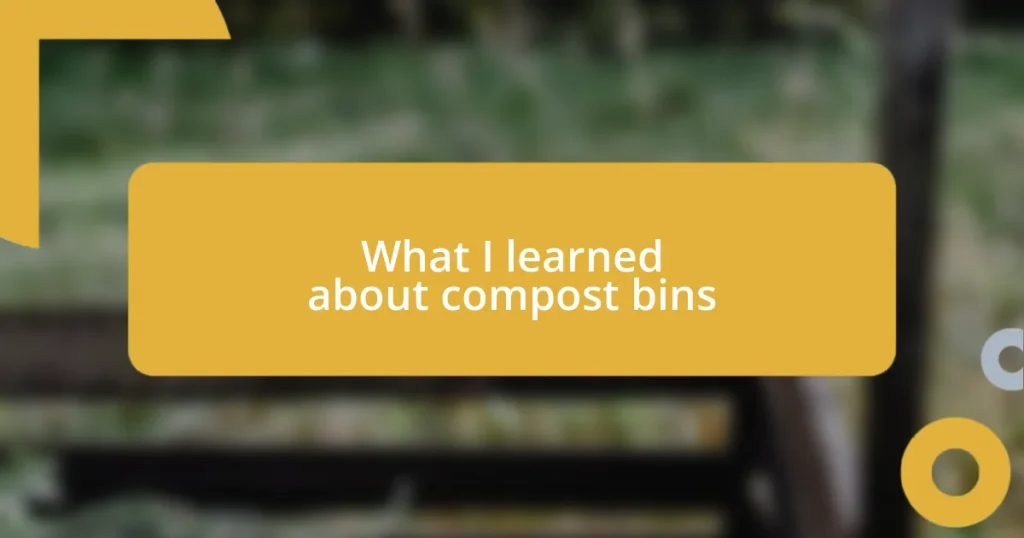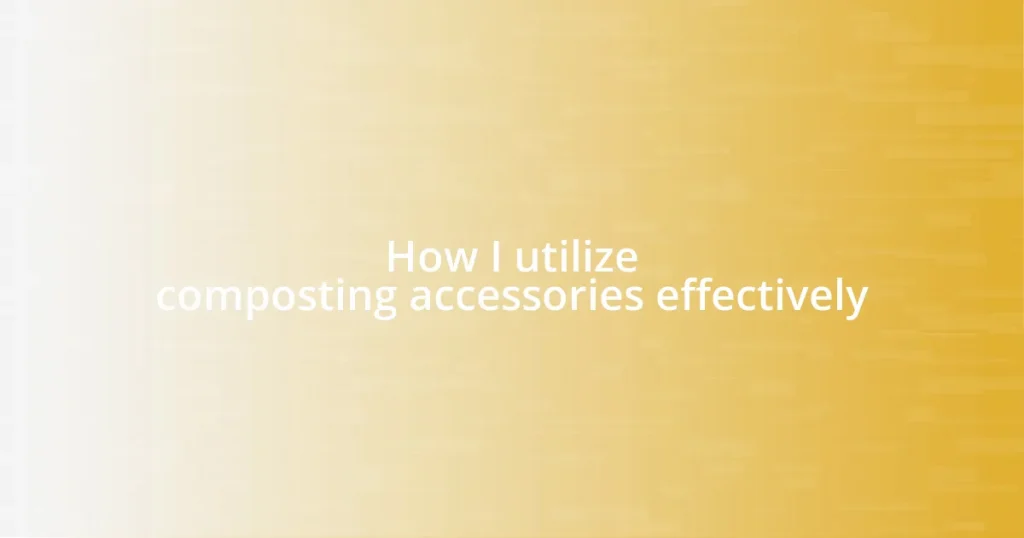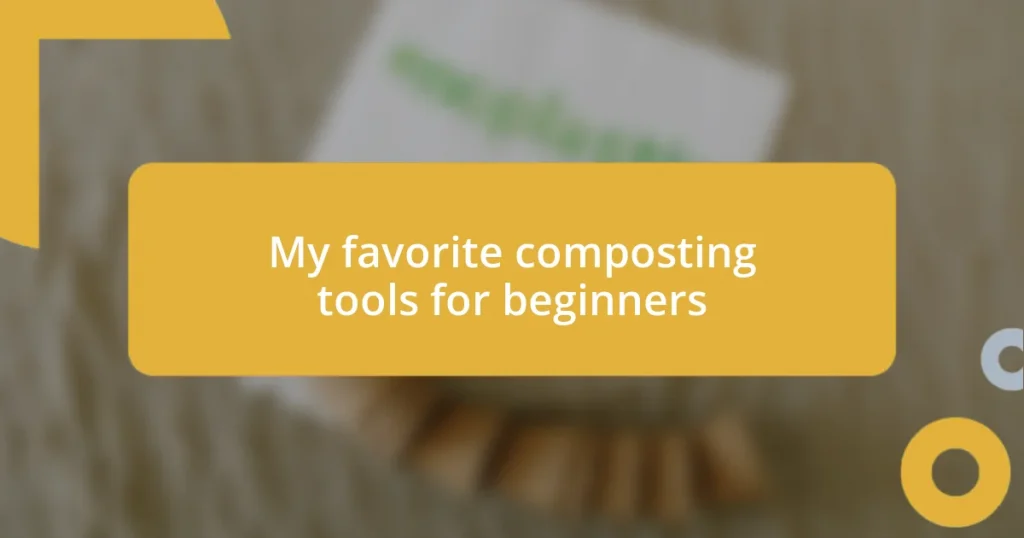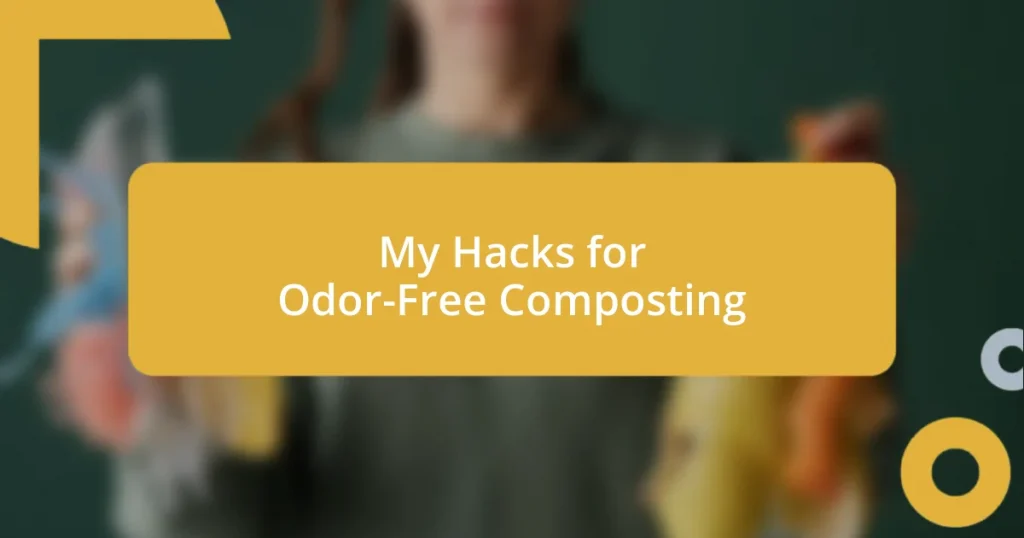Key takeaways:
- Compost bins significantly reduce landfill waste and improve soil health, creating a positive environmental impact.
- Different types of compost bins (traditional, tumblers, vermicomposting) cater to various preferences and spaces, enhancing the composting experience.
- Proper maintenance, including balancing greens and browns, ensuring moisture, and troubleshooting issues, is crucial for effective composting.

Understanding compost bins
Compost bins are fascinating tools that transform kitchen scraps and yard waste into nutrient-rich compost. I still remember the first time I dumped my vegetable peels into the bin, feeling a mix of excitement and skepticism. Would this really turn into something useful? And to my delight, it did!
One of the most eye-opening aspects of compost bins is their ability to reduce landfill waste. While I was sorting my trash, I often wondered why so much food waste ends up in landfills, contributing to harmful methane emissions. Using a compost bin not only makes me feel like I’m helping the environment but also gives me a sense of purpose, knowing that I’m contributing to a healthier planet.
There’s a certain rhythm to maintaining a compost bin that I truly enjoy. It’s almost meditative as I layer greens and browns, mixing in air and moisture. Have you ever found a hobby that so seamlessly ties you to nature? For me, tending to my compost bin feels like a tangible way to give back to the earth, enriching the soil that grows my vegetables and flowers.

Types of compost bins
Compost bins come in various types, each catering to different needs and preferences. One that I’ve found particularly interesting is the traditional compost bin, which usually consists of a simple enclosed structure. The first time I saw one in my neighbor’s yard, I imagined it was just a glorified trash can! However, as I learned more, I realized it’s a brilliant way to manage organic waste, creating a perfect environment for decomposition without attracting pests.
Then there are compost tumblers, which I’ve personally tried out. They’re designed for quick mixing and aeration, making the composting process faster. I vividly remember my initial struggle with the tumbler’s mechanism. After a bit of practice, it became quite fun to spin it around, and I felt a sense of accomplishment each time I checked the progress. This type has helped me get rich compost in as little as a few weeks!
Lastly, there’s vermicomposting, or composting with worms, which is a bit more specialized. When I first introduced worms into my composting routine, I was both fascinated and a little squeamish. It surprised me how efficient these little creatures are at breaking down scraps into nutrient-dense compost. We often think about composting as an outdoor activity, but these bins can fit perfectly in my home, turning food waste into “black gold” in a compact manner.
| Type of Compost Bin | Features |
|---|---|
| Traditional Bin | Simple structure, enclosed for odor control |
| Compost Tumbler | Easy mixing, faster breakdown of materials |
| Vermicomposting | Utilizes worms, compact size, great for indoor use |

Benefits of using compost bins
Using compost bins brings a host of benefits that can genuinely enhance both our gardening experience and our environmental impact. Since I started composting, I’ve noticed my garden thriving. The compost acts as a natural fertilizer, strengthening the soil and making my plants more resilient. I remember the moment my tomato plants bore a bountiful harvest—something I attribute directly to the enriched soil from my compost.
Here are some benefits of using compost bins:
- Waste Reduction: Compost bins significantly decrease the amount of waste sent to landfills, helping in the fight against environmental pollution.
- Soil Enrichment: The resulting compost improves soil structure, promotes healthy plant growth, and fosters biodiversity by introducing beneficial microorganisms.
- Cost Savings: Homemade compost reduces the need for chemical fertilizers and soil amendments, saving money in the long run.
- Learning Experience: Managing a compost bin taught me about decomposition and nutrient cycles, enriching my understanding of nature’s processes.
- Tasteful Produce: My homegrown vegetables taste fresher and richer, which I attribute to using nutrient-dense compost. There’s a noticeable difference!

Choosing the right compost bin
Choosing the right compost bin can feel overwhelming at first, but it’s a journey worth taking. Personally, I found that assessing my available space played a key role in my decision. For instance, I live in a small apartment, so compact options, like a vermicomposting bin, made perfect sense. When I saw how easily it fit on my kitchen counter, I thought, “Why didn’t I do this sooner?”
Once I got into the nitty-gritty of choosing, I realized that understanding the type of materials I planned to compost was crucial. I had quite a few yard waste and kitchen scraps, so I leaned toward a traditional bin for its larger capacity. The moment I threw in my first load of grass clippings followed by vegetable peels, I felt a mix of excitement and anticipation. It was like creating a mini ecosystem right in my backyard!
Lastly, price is always a consideration, but I often ask myself: Is it worth investing in quality? When I discovered some compost tumblers could be a bit pricier, I weighed the benefits—like faster decomposition and less effort in mixing. A little splurge on the right bin might just give me a garden full of vibrant veggies, and honestly, that’s a reward I couldn’t resist. What’s a little more upfront cost when the payoff is so fruitful?

Proper compost bin maintenance
Proper maintenance of your compost bin can be a game changer in the composting process. I remember when I first started; I was so eager that I overlooked the importance of aeration. Regularly turning the pile not only speeds up decomposition but also prevents unpleasant odors. Honestly, the first time I opened my bin after a good mix, the earthy smell was invigorating, and seeing the transformation made me feel accomplished.
One of the key lessons I’ve learned is the balance of greens and browns. Initially, I tossed everything in there haphazardly, thinking it would all break down on its own. However, I quickly realized that too many kitchen scraps (the greens) without enough carbon-rich materials (the browns) led to a soggy mess. Finding that right ratio—about one part greens to three parts browns—has become a satisfying routine for me. Has balance ever felt so rewarding?
Lastly, moisture control is crucial. There were times I forgot about my compost bin during a dry spell, and the contents became too dry to decompose effectively. A quick sprinkle of water solved the issue, and it was like watching life return to my pile. Now, I always check the moisture level, making sure it feels like a wrung-out sponge. It’s a small but vital part of the process that ensures my compost is active and ready for my garden. I’ve come to appreciate the little things that make a big difference in composting!

Troubleshooting common composting issues
Troubleshooting composting issues can often feel like solving a mystery. I remember once opening my compost bin only to be greeted by a smell that could only be described as less than pleasant. It turned out I had added too many wet materials without enough airflow. After some research, I learned that ensuring adequate ventilation can significantly reduce odors—so I started using a pitchfork to mix things up regularly. The first time I noticed the fresh scent of soil instead of the sour stench, I let out a satisfied sigh.
Another common hiccup I encountered was pest invasion. I just brushed it off at first, thinking they were part of nature’s cycle. But after discovering fruit flies buzzing around my kitchen, I realized this wasn’t a welcome guest scenario. I quickly learned to bury kitchen scraps deep within the pile and avoid adding overly ripe fruit. Isn’t it funny how a little preventative measure can save you from a swarm of uninvited diners?
It’s also important to keep an eye on temperature. During the colder months, my compost pile seemed to slow down. I felt a wave of discouragement wash over me; I thought my efforts were in vain! Then, I stumbled upon the idea of insulating the bin with straw bales. The next time I checked in, the warmth radiating from the center was a reminder of how resilient nature can be. Have you ever discovered solutions in the most unexpected places? It’s moments like these that make composting not just a task, but a truly engaging journey.

Enhancing compost quality and efficiency
Enhancing compost quality and efficiency is all about understanding the factors that drive decomposition. I remember one particularly hot summer when I decided to experiment with adding worms to my bin. I was skeptical, thinking they might just make things messier. Instead, they transformed my compost into lush, crumbly gold within weeks. It felt like I had discovered the secret weapon of composting! Isn’t it fascinating how nature often provides solutions that seem almost magical?
Another strategy that significantly improved my compost quality was layering. Initially, I just dumped everything into the bin haphazardly. However, I stumbled upon the idea of creating layers—mixing greens and browns alternately. This practice not only enhanced airflow but also made it easier for the microorganisms to get to work. The first time I looked in after layering, the heat radiating from the bin was thrilling. Have you ever felt like you’ve tapped into a natural cycle just by altering your approach?
Lastly, I can’t stress enough how much the size of your compost materials affects efficiency. In my early days, I tossed in whole corn cobs and half-cut branches, thinking they’d break down eventually. But when I began chopping up my waste into smaller pieces, it was like watching a race between nature’s processes and the clock. I realized that smaller bits not only decompose faster, but they also create a richer compost. Don’t you love those moments when a small tweak leads to a giant leap in progress?

